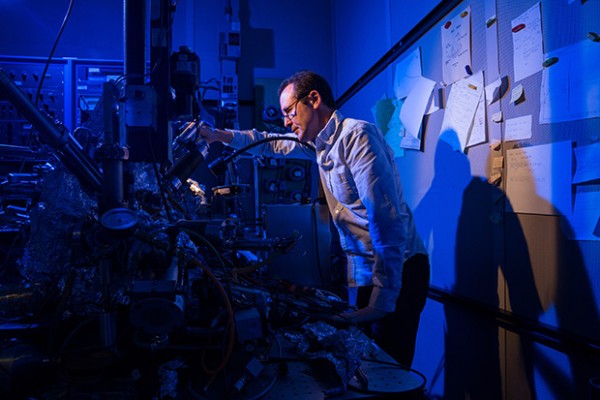By Ana Verayo, | March 13, 2017

Christopher Lutz of IBM Research with IBM Research's Nobel-prize winning microscope he used to store data on a single-atom magnet.
Computer scientists from IBM developed a new way to store data by using just a single atom. This new discovery is not intended for commercial development researchers say, but more for exploring the field of computing technology.
According to co-author of the study, Christopher Lutz of IBM Research, our new study is not about product development but this is basic research to develop more tools and to understand miniaturized devices such as stretching the limits to an individual atom. Lutz and the team are planning to develop new data technologies and using single atom-magnets is the first step in doing so.
Like Us on Facebook
In this new study, the IBM team was able to use a single atom and one of the world's rarest elements known as holmium. This rare earth metal is also embedded in magnesium oxide. The team also utilized a special microscope and a small, high accuracy needle to administer an electric current inside the holmium atom. This process causes the atom to flip its orientation from north to south or vice versa. Upon flipping, the atom will be able to register binary code of ones and zeroes.
The team of researchers was also able to measure the electromagnetic properties of this holmium atom in order to read the encoded data. New findings revealed that holmium atoms are capable of stabilizing their given field orientation for a long period of time. This also strongly suggests that atoms can be reliable data storage systems.
These successful results still does not mean that computer and data storage manufacturing companies can now sell atoms as data storage systems. The feasibility of this atom data storage is too complex since a holmium atom can only work in a negative 459 degrees Fahrenheit room. Room temperatures or warmer temperatures will only make these atoms disappear.
Apart from temperature and environment conditions, these atoms also require a special magnetic tape to flip their orientation where this process also requires utmost precision. Researchers also note that in order for this single atom data storage to work, any vibrations or disturbances during the process should be eliminated to write, encode and read any data in the atom.
This new study is published in the journal Nature.
-
Use of Coronavirus Pandemic Drones Raises Privacy Concerns: Drones Spread Fear, Local Officials Say

-
Coronavirus Hampers The Delivery Of Lockheed Martin F-35 Stealth Fighters For 2020

-
Instagram Speeds Up Plans to Add Account Memorialization Feature Due to COVID-19 Deaths

-
NASA: Perseverance Plans to Bring 'Mars Rock' to Earth in 2031

-
600 Dead And 3,000 In The Hospital as Iranians Believed Drinking High-Concentrations of Alcohol Can Cure The Coronavirus

-
600 Dead And 3,000 In The Hospital as Iranians Believed Drinking High-Concentrations of Alcohol Can Cure The Coronavirus

-
COVID-19: Doctors, Nurses Use Virtual Reality to Learn New Skills in Treating Coronavirus Patients







